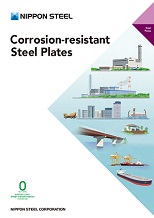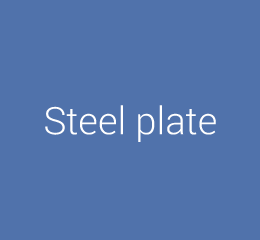
News
- Apr. 18, 2025 The civil engineering package has been updated with the addition of “Hat+H (Hat-type sheet pile for Deep excavation)” and “STEEL PIPE PILES with ribs x Sat-in Pile Foundation”.
- Apr. 02, 2025 Designing Metal TranTixxii to be Used in the Largest Quantity in the World on Taiwanese Temple Roof
- Mar. 10, 2025 Nippon Steel Obtained SuMPO EPD Certifications for Pipes and Tubes Used in Chemical Industry and for Boilers
- Dec. 12, 2024 Titanium with Aesthetic Appearance “TranTixxii” Service Life Warranty Launch —Launch of a maximum 150-year warranty through additional extensions—
- Oct. 31, 2024
Launch of the overseas version of ProStruct™, a solution brand for the construction industry
—Expanding the packaged series of steel materials and solution technology to overseas construction markets— - Oct. 30, 2024 Participation in the Japan Pavilion at ADIPEC, the Energy-Related Exhibition in the Middle East
- Oct. 07, 2024 Nippon Steel Obtained SuMPO EPD (Formerly EcoLeaf) Certificationsfor Its Hot Extruded Steel Shapes
- Jul. 10, 2024 Long-term OCTG supply contract with Aker BP renewed –Strengthens strategic partnership through stable supply of OCTG–
- Jul. 03, 2024 Long-term OCTG supply contract with Equinor renewed –Strengthens strategic partnership through stable supply of OCTG–
- Jun. 14, 2024 Acceptance of Orders for High-Alloy Seamless OCTG and Employment of Green Steel “NSCarbolex Neutral” Finalized for CCS to Be Used in Construction Project for Blue Ammonia Manufacturing Plant in the State of Qatar
- May. 15, 2024 Adoption of Coating Cycle Extension Steel “CORSPACE” for the First Time in Overseas ODA Bridge Construction
- Apr. 23, 2024 Participation in OTC, an Energy-Related Exhibition in the U.S.
- Mar. 22, 2024 Designing Titanium TranTixxii wins the European “iF DESIGN AWARD 2024” —The world's first non-ferrous metal material to receive the award—
- Sep. 28, 2023 The Adoption of “NSCarbolex Neutral” steel product for geothermal project in the Netherlands operated by 85 Degrees Renewables.
- Mar. 11, 2022 Nippon Steel's TranTixxii and NIPPON STEEL Stainless Steel Corporation's NSSC220M featured on the roof of an international conference center in Jiangsu, China
- April 22, 2021 Nippon Steel to Launch ZAM®-EX high corrosion resistant coated steel sheets for overseas markets
- Oct. 01, 2020 Our new product "FeLuceTM" (hairline-finished electroplated steel sheet) wins the Good Design Award 2020 ~Our first steel sheet to win the Good Design Award~
- Feb. 14, 2019 NSSMC Receives Shell’s Supplier Award
- Jul. 30, 2018 Execution of Strategic Partnership with BP Oman
- Jul. 30, 2018 "The beauty of distinctive gradations make people feel nature" was posted.
- Jul. 26, 2018 VAM® 21 HT CLEANWELL® DRY ST First Running
- Jul. 19, 2018 Steel Wires Joint Venture Company for Cold Heading and Forging in USA (NSCI) holds an Opening Ceremony
- Jun. 27, 2018 NSSMC and Standard Steel Receive TTX “Excellent Supplier 2017” Award
- May. 29, 2018 NSSMC Named a Top 100 Global Innovator in 2017 for Sixth Consecutive Year
- Apr. 25, 2018 Steel Wires Joint Venture Company for Cold Heading and Forging in USA (NSCI) Starts Commercial Production
- Apr. 17, 2018 Strengthening Supply System for Ultra-high-tensile Steel Sheets New CGL to be installed at Kimitsu Works
- Feb. 27, 2018 Nippon Steel & Sumikin Crankshaft, NSSMC’s manufacturing and sales subsidiary of crankshafts in the U.S., earns Diamond Supplier Award from Navistar
- Aug. 04, 2017 NSSMC’s proprietary titanium product TranTixxii™ is adopted for cladding of a theater in Jiangsu Province, China
NSGP™-1&2
NSGP-1&2: Suppressing the Development of Corrosion in Two Different Corrosive Environments—Tank Bottom Plate Sections and Tank Rear Sections
Highly corrosion-resistant NSGP features both paint-free application and high performance
as a steel plate for crude oil tankers. It is available in two grades: NSGP-1 for bottom plate sections
of tanks and NSGP-2 for rear sections of tanks, both of which demonstrate the highest level of corrosion
resistance due to the addition of trace amounts of alloying elements.
NSGP-1&2 have already been applied in the record number of tankers in the world, and have proven
world-class reliability through year-long application tests in working tankers over ten years. Their
paint-free performance enables reductions in both maintenance costs and shipbuilding costs. Also, the
welding and fabrication of NSGP steel plates can be conducted in the same manner as conventional steel
plates, and thus no special process control is required.
Furthermore, NSGP-1&2 help to prevent environmental contamination caused by painting and offer
diverse benefits in shipbuilding and maintenance.
*NSGP: Nippon Steel Green Protect
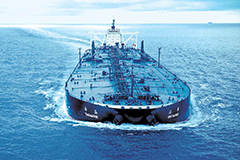
Highly Corrosion-resistant Steel Plate for Bottom Plate Sections of Crude Oil Tankers NSGP-1
The pitting (pitting corrosion) that occurs in the bottom plate sections of crude oil tankers has conventionally been a critical problem. NSGP-1 can suppress the occurrence of this corrosion. Nippon Yusen Kaisha and NIPPON STEEL have developped NSGP-1 and in 2004, this product was experimentally adopted in a tanker and, in a periodic inspection 2.5 years later, demonstrated that it remained free of pitting corrosion, even under paint-free conditions. NSGP-1 has since been applied in many tankers.
Highly Corrosion-resistant Steel Plate for Tank Rear Sections of Crude Oil Tankers NSGP-2
Every surface of upper decks (ceiling parts) is subject to corrosion. NSGP-2 can suppress such corrosion thanks to corrosion-protection performance derived from original research. This plate formally came to market in 2014 after diverse application tests conducted on working tankers. Particularly the shape of the ceiling(deck) sections of most tanks is complex, and thus the time required for repairs can be significantly reduced due to the paint-free properties peculiar to NSGP-2.
Features
Reducing Corrosion in Tank Bottom Plate Sections to 1/15 NSGP-2
There are cases in which the depth of pitting (pitting corrosion) that occurs in the bottom plate
sections of tanks reaches 4 mm or more in a year. If left untended for five years, there is a danger of
such pitting corrosion to penetrate entirely through the plate thickness.
Even in a comparison of the number of occurrences of pitting corrosion of 4 mm or more in depth (per
tank) after five years of service, tanks using conventional steel registered about 200 instances, while
tanks using NSGP-1 registered about 13 instances-reduction to less than 1/15. This proves that NSGP-1
possesses high corrosion resistance.
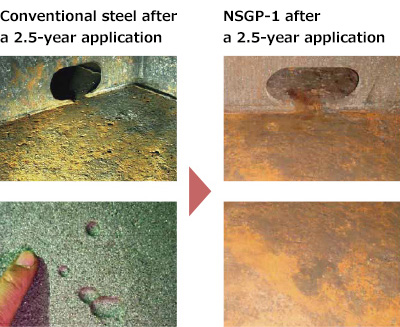
Comparison of Number of Occurrence of Pitting Corrosion (4 mm or more in depth) after Five-year Application
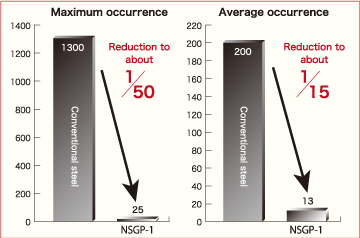
While pitting corrosion to a depth of 4 mm or more occurs at as many as 1,300 locations in tankers using conventional steel over a five-year service period, the adoption of NSGP-1 can suppress the maximum occurrence of such corrosion to about 1/50 that of conventional steel, or 1/15 in average.
Comparison of Corrosion Test Results for Welding Material
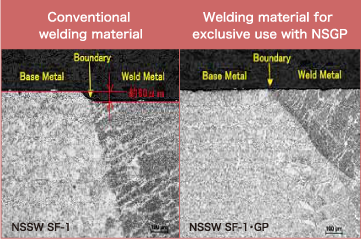
Conventional welding materials show a large degree of corrosion in corrosion tests, and welds made with these materials are sometimes rejected in welding inspections due to corrosion in weld boundaries. In order to secure reliable welding, highly corrosion-resistant welding materials for exclusive use with NSGP have been prepared.
Reducing Corrosion in Tank Rear Sections by About 60%
The ceiling (or deck) plate section of a tank presents two factors attributable to the progress of
corrosion.
One of these is the corrosive environment caused by the waste gas and the effect of H2S that
escapes from crude oil as mentioned above. Another factor is the adverse conditions caused by repeated
drying and condensation due to daytime and nighttime temperature differences resulting from the fact
that the ceiling plate sections of the tanks also collectively serve as the deck of a tanker. It is
reported that the average corrosion rate of these ceiling sections using conventional steel reaches
nearly 0.1 mm/year, but there is the possibility of this level being exceeded depending on the change of
the application environment.
It has been proven from the results of 10-year application of NSGP-2 in working tankers that the
estimated loss of plate thickness of NSGP-2 after 25 years can be suppressed to about 60% that of
conventional steel.
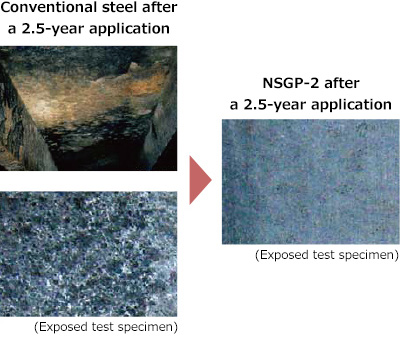
Comparison of Change in Corrosion Loss
When corrosion loss over a 25-year span is estimated from 10-year application of conventional steel and NSGP-2 in working tankers, it is predicted that, while corrosion loss in conventional steel will surpass the target value of 2 mm, the corrosion loss in NSGP-2 will be held to about 60% that of conventional steel.
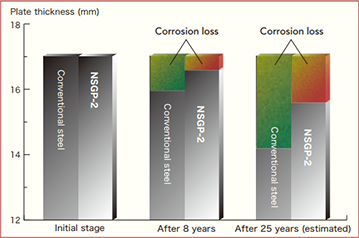
Approval of Ship Classification Societies by Satisfying IMO Rule
NSGP-2 is the first plate in the world to acquire approval from classification societies as a steel product that satisfies the IMO rules. Recognition by other classification societies is anticipated. Although NSGP-2 has acquired application approval not only as ceiling plate but as bottom plate as well, only its application as ceiling plate is recommended.
| Target application | Grade of NSGP | Suffix to material symbol | Approval-acquired ship class | Specifications obtained | Plate thickness |
|---|---|---|---|---|---|
| Bottom plate |
NSGP-1 | -RCB | NK,ABS,(LRS) | AH32, DH32 AH36, DH36 |
≦30mm |
| Ceiling plate |
NSGP-2 | -RCU (-RCW) |
NK,ABS,LRS | AH32, DH32 AH36, DH36 |
≦30mm |
Examples of use
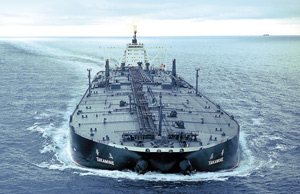
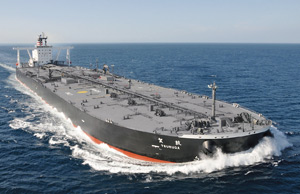
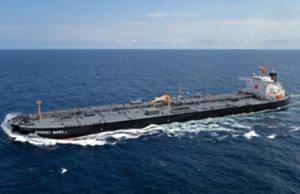
Catalogs
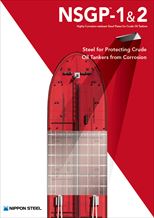
- NSGP-1&2 Debut as the World's First Paint-free Highly Corrosion-resistant Steel Plates
- Enhancing Application Effectiveness by the Combined Use of NSGP-1 and NSGP-2
- Two Types of NSGP, 1 and 2, Have Been Developed by Means of Original Approaches
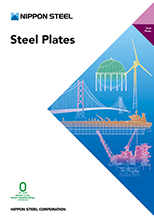
- Features
- Available Grades
- Authorized Steel Grades by Product Type
- Manufacturing Process and Quality Control Points
- Thermo-Mechanical Control Process (TMCP)
- 400 N/mm2-class Tensile Strength Steel Plates (As-rolled) Available Sizes
- 490 N/mm2-class Tensile Strength Steel Plates (As-rolled) Available Sizes
- 490 N/mm2-class Tensile Strength Steel Plates (TMCP: Thermo-Mechanical Control Process) Available Sizes
- Weldable High-tensile Strength Steel Plates: WEL-TENTM Series
- Abrasion-resistant Steel Plates: ABREXTM Series
- Abrasion-resistant Steel Plates for Low Temperatures: ABREXTM LT Series
- Low-temperature Steel Plates: N-TUFTM Series
- Sulfuric Acid-resisting Steel Plates: S-TENTM Series
- Ni-Added Weathering Steel Plates: NAW-TENTM Series
- Highly Corrosion-resisting Steel Plates: COR-TENTM Series
- Corrosion-resistant Steel Plates for Export: COR-TENTM
- High Tensile Steel Plates for Building Structures: BT–HT Series
- Steel Plates for Elasto-plastic Hysteretic-type Dampers for Building Structures: BT-LYPTM
- Electromagnetic Mild Steel Plates: NS–MIPTM
- Information Required for Orders
- Examples of Marking
- Conclusions
- Reference for Use of Steel Plates
- Reference Tables of Standards
- NIPPON STEEL Specifications Table of Correlations between Old and New Specifications
Contact Information
For further product information
Product Quotes, and inquiries without complete information required in inquiry form may not be responded to. Selection of inquiries for reply online is at the sole discretion of NIPPON STEEL. We appreciate your understanding.
